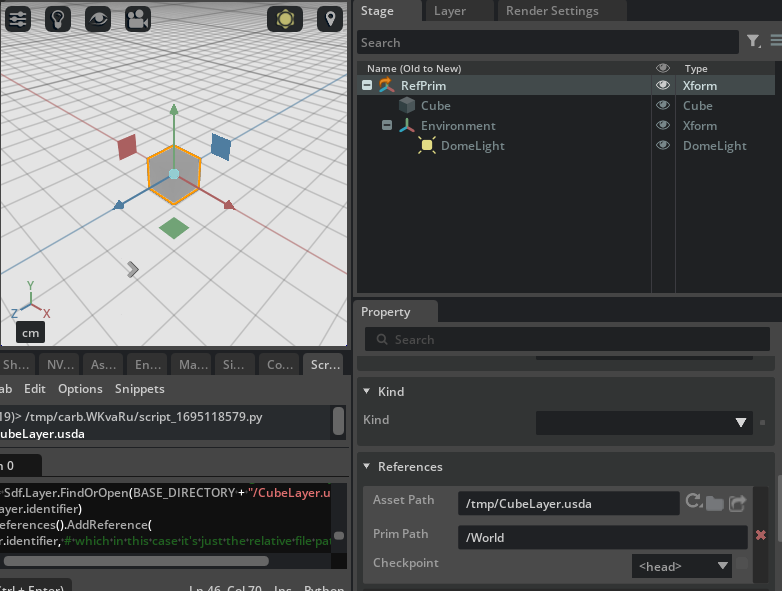References
In the same fashion as the sublayers example we explored before, let’s create a prim with a references metadata that references another layer in a different USD file and open it in OV Composer (this script can be run in the Script Editor in OV Composer directly)
from pxr import Sdf, UsdGeom, Usd, UsdLux, Gf
import omni.usd
import carb
BASE_DIRECTORY = "/tmp" # This is where the .usda files will be saved
root_stage : Usd.Stage = Usd.Stage.CreateInMemory("RootLayer.usda")
cube_stage : Usd.Stage = Usd.Stage.CreateInMemory("CubeLayer.usda")
# Create a Cube "Cube" prim in the cube stage and a light
xform : UsdGeom.Xform = UsdGeom.Xform.Define(cube_stage, Sdf.Path("/World"))
cube : UsdGeom.Cube = UsdGeom.Cube.Define(cube_stage, "/World/Cube")
extent = [(-50, -50, -50), (50, 50, 50)]
cube.GetExtentAttr().Set(extent)
cube.GetSizeAttr().Set(100)
# This time put the light under the "/World" prim - by referencing "/World" we will also
# import the lights as well since they're under "/World"
environment_xform = UsdGeom.Xform.Define(cube_stage, "/World/Environment")
dome_light = UsdLux.DomeLight.Define(cube_stage, "/World/Environment/DomeLight")
dome_light.CreateIntensityAttr(1000)
# Export to file
cube_stage.GetRootLayer().Export(BASE_DIRECTORY + "/CubeLayer.usda")
# A pseudo-root prim (usually the '/' prim) exists solely to namespace all prims' paths under
# this prefix (e.g. "/World"). A UsdStage always has a pseudo-root prim (unless there was an
# error opening it)
root_prim : Usd.Prim = root_stage.GetPseudoRoot()
# Verbose to showcase API usage for "/RefPrim". Creates a generic UsdPrim (it will default
# to being an Xform)
ref_prim : Usd.Prim = root_stage.DefinePrim(str(root_prim.GetPath()) + "RefPrim")
# This would NOT work because as soon as this script finishes executing, the temporary stages
# would be destroyed (they're weakrefs). Let's open and reference the usd file for those
# layers instead
# nope: ref_prim.GetReferences().AddReference(cube_stage.GetRootLayer().identifier)
loaded_layer = Sdf.Layer.FindOrOpen(BASE_DIRECTORY + "/CubeLayer.usda")
ref_prim.GetReferences().AddReference(
loaded_layer.identifier, # which in this case it's just the relative file path string
"/World") # The prim which needs to be mapped at the ref_prim also needs to be specified
# Export root stage to file
root_stage.GetRootLayer().Export(BASE_DIRECTORY + "/RootLayer.usda")
# Issue an 'open-stage' command to avoid doing this manually and free whatever stage
# was previously owned by this context
omni.usd.get_context().open_stage(BASE_DIRECTORY + "/RootLayer.usda")
Here’s the result in OV Composer: a prim is added to the root prim that references the outside layer (OV Composer adds a small orange arrow to the icon of the xform to indicate that the prim has a reference metadata and that references something during the stage composition)

If we inspect the generated USD files we can see the reference metadata
$ cat /tmp/CubeLayer.usda
#usda 1.0
def Xform "World"
{
def Cube "Cube"
{
float3[] extent = [(-50, -50, -50), (50, 50, 50)]
double size = 100
}
def Xform "Environment"
{
def DomeLight "DomeLight"
{
float inputs:intensity = 1000
}
}
}
$ cat /tmp/RootLayer.usda
#usda 1.0
def "RefPrim" (
prepend references = @/tmp/CubeLayer.usda@</World> # Here it is
)
{
}
Note what happens if we save the USD file with OV Composer as flattened:
$ cat /tmp/Flattened.usda
#usda 1.0
(
doc = """Generated from Composed Stage of root layer /tmp/RootLayer.usda
"""
)
def Xform "RefPrim"
{
def Cube "Cube"
{
float3[] extent = [(-50, -50, -50), (50, 50, 50)]
double size = 100
}
def Xform "Environment"
{
def DomeLight "DomeLight"
{
float inputs:intensity = 1000
}
}
}
i.e. only the composed elements are retained and the composition arcs are resolved into a single, flattened, hierarchy. This is very useful when dealing with e.g. huge Nucleus USD files which reference multiple-networks-scattered USD files and you want to save a copy (albeit probably huge) of the USD scene for debugging purposes on your local workstation: you flatten it out and save it to disk.
Note that overriding attributes works exactly as before: even if the cube had an opinion in the original CubeLayer
# Give it a red color (quick way to apply a 'debug' color without shaders or materials - accesses primvar variables)
cube.GetPrim().CreateAttribute("primvars:displayColor", Sdf.ValueTypeNames.Color3fArray).Set([(1.0, 0.0, 0.0)])
# Export to file
cube_stage.GetRootLayer().Export(BASE_DIRECTORY + "/CubeLayer.usda")
we could have overridden that attribute with an override (that would appear as a delta on the referenced layer) in the root layer
# Give it a blue color override in the root layer
override_cube_prim : Usd.Prim = root_stage.OverridePrim("/RefPrim/Cube")
override_cube_attr = override_cube_prim.CreateAttribute("primvars:displayColor", Sdf.ValueTypeNames.Color3fArray)
override_cube_attr.Set([(0.0, 0.0, 1.0)])
# Export root stage to file
root_stage.GetRootLayer().Export(BASE_DIRECTORY + "/RootLayer.usda")
In the code above we apply a displayColor in the original cube stage by accessing that attribute via the UsdGeomPrimvar schema. This is a schema that allows to access and modify attributes which are specific to geometry prims (i.e. prims like cameras and such do not implement such schema), stuff like visibility or interpolation are under control of this schema. It’s a quick way to visualize a simple shaded color for a geometric prim without setting a material.
The final color of the cube would have been blue: root layer wins in this case. Had the blue opinion come from a variant (lower in the LIVRPS ordering), the reference opinion would have won.